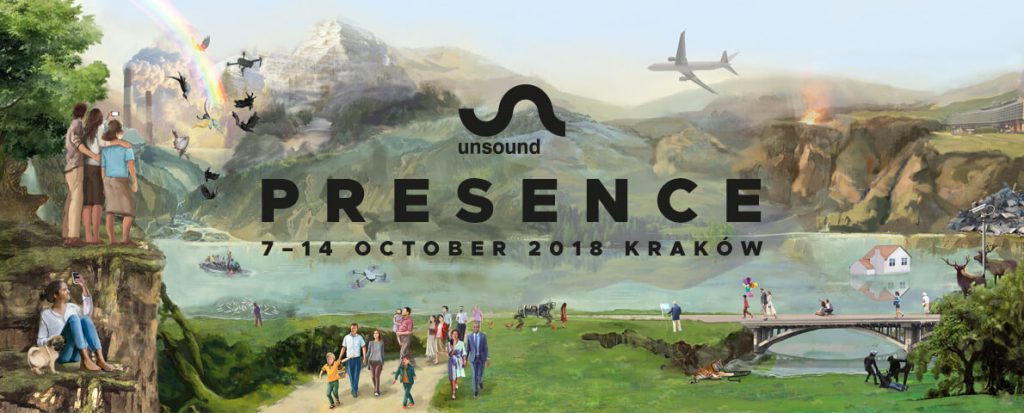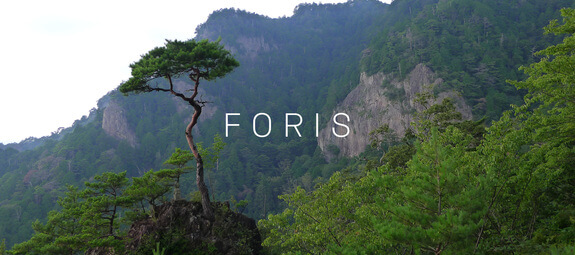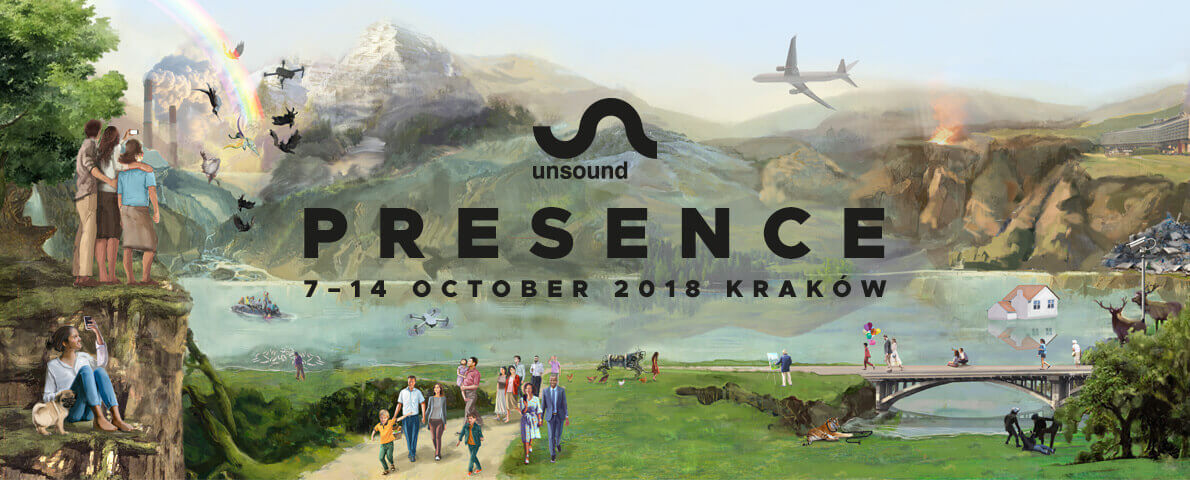Text by CLOT Magazine

At just a few days to kick-off, the final Unsound Kraków programme has just been announced with the final additions of the day programme. The 16th edition of Unsound Kraków starts this Sunday, 7th October, with the theme of Presence. In addition to already-announced music shows, film screenings and workshops, an extensive talk programme and installations have been disclosed. Here are some of our highlights for a week ahead of intellectual and sensorial enhancement.
As already announced, the Ephemera follow-up, Foris, is part of the series of synaesthetic installations and live performances connecting sound, light and scent. Centred around the idea of preserving endangered ecosystems in the era of the Anthropocene, in Foris, sound recordist and artist Chris Watson, olfactory artist and perfumier Geza Schoen and light and visual artist MFO will try to recreate a forest with a multichannel installation of field recordings of selected habitats from across the planet interconnected with the olfactory concept of a forest created by Geza Schoen.
Geza shared with us that the challenge in translating the smells of a forest lies in the sense of a realistic portrait as such. You need to get the wet/dry notes right to evoke an impression of the real sensation of breathing in the forest. What is the first smell that comes up to his mind when thinking about a forest: woods? Then the damp earthiness. The combination of physical with olfactoric impressions is unique. It is a complex structure overall with different facets, which range from the wet leafy freshness to more resinous woody darker notes.
We are eager to see the screening of Kristen Gallernaux‘s The Hum followed up by the presentation of her new book High Static, Dead Lines: Sonic Spectres & the Object Hereafter (which she is also presenting in London on the 8th of October), covering her professional curatorial strategies in sonic research, the history of technology, remixing Internet culture and pastoral horror.
The Hum, the accompanying film, reconstructs a visual and sonic impression of the spatial, psychic-industrial, and physiological effects of “the hum” — vibroacoustic effects of infrasound that affect people, animals and local landscapes, particularly the one experienced in Detroit.
Other interesting talks and panels, re:senset, portrays one of the pioneering art and science artworks, Senster: a massive steel kinetic sculpture commissioned in the late ’60s by the electronics giant Philips. It was constructed to react to sound and motion in its surroundings and programmed on a P9201 prototype computer.
Anna Olszewska of Kraków’s AGH University of Science and Technology will discuss its reconstruction, which will also be displayed. On another panel, Chris Watson and Todd Barton, in conversation with Luke Turner, will discuss on the disrupted tourist ecosystems posed by climate changes. Chris will also be in conversation with Andy Battaglia, discussing his work as a sound artist who has travelled the most remote part of the globe in search of the unheard sound of nature.
Stefanos Levidis from Forensic Architecture, the multidisciplinary research agency based at Goldsmiths University of London, will show the agencies’ most recent work undertaking the spatiotemporal analysis of crime scenes in an attempt to procure obscured evidence for public dialogue. Moor Mother, also known for being half of the multidisciplinary collective Black Quantum Futurism alongside Rasheedah Phillips, will discuss her multidisciplinary practice again with Andi Battaglia.
Apart from The Hum, other interesting films include Lawrence Lek’s Geomancer (a dystopian and extremely aesthetic virtual world through the creative views from the eyes of artificial intelligence) and the documentary on Donna Haraway’s life and ideas. Haraway is key in discussing media saturation, cyborgization, and the Anthropocene. The screening will be tempting for those interested in deepening how gender and identity are reinterpreted in a contemporary technological environment and ideas of cybernetically enhanced humans.
This year the Unsound team have built up a considerable workshop programme. Renick Bell and Miri Kat, leading figures in live coding and the Algorave movement, will lead one of the workshops on coding music live. Not to be missed either, the Mark Fisher reading groups.
The late writer and philosopher’s K-punk blog redefined cultural criticism with its blend of pop culture, philosophy, and politics and deeply influenced the generation of musicians, artists and writers. His new book K-punk, released by Repeater Books, will premiere at Unsound. These two reading groups provide an opportunity to remember and celebrate his work in an intimate context through close readings of some of his most important writings.

Moving onto the extensive music programme, two of the exciting past venues are recovered for this year’s editions the Synagogue Temple, which will see Todd Barton presenting for the first time live Music and Poetry of The Kesh, a collaboration album with Ursula K. Le Guin, of songs and poems, recited in an invented language, made with invented instruments.
The medieval Salt mine outside of Krakow will see Lucrecia Dalt performing a spectral electroacoustic show based on her recent album Anticlines, followed by minimalist music legend Terry Riley performing alongside his son Gyan. The lush interiors of Teatr im. Juliusza Słowackiego will see the new show and music of Tim Hecker and a homage to the music of the late Jóhann Jóhannsson.
Worldwide acclaimed Company Wayne McGregor presents the European premiere of Autobiography Edits. This show is a compact, specially produced version of choreographer Wayne McGregor’s dance work Autobiography, inspired by McGregor’s own DNA sequence. To celebrate the release of her original score on Planet Mu, Jlin performs live on stage alongside the dancers.
Nick Rothwell developed the algorithm in collaboration with choreographer Wayne McGregor, which is used to determine the order of the dance pieces performed at each show of Autobiography. Autobiography Edits, though, is not dictated by the algorithm (it has a fixed order) due to the varying technical and staging challenges of the more unusual venues.
Minimalist sound artist Alva Noto will perform his most recent show UNIEQAV, a performance blending science, data, and minimalist electronic music and on the same night, an interesting political act AUDINT takes us on a trip through Trump’s White House, a rogue AI, the mysterious “health attacks” on US Embassies in Havana and Guangzhou, and the weaponisation of sonic fiction.
Tomoko Sauvage, the Japanese musician who investigates the properties of sound and improvisation in relation to the environment, will present a piece specially commissioned for the occasion. She is known for her work exploring the sonic properties of water with chiming vessels that turn tuned water into a sort of natural synthesizer.
All these names add to the extensive evening and night programme that includes the likes of Lena Willikens, Marie Davidson, Gaika, Kode9, We will Fail, Andrea Belfi and Valerio Tricoli, Michal Wolski, House of Kenzo, Ewa Justka, Drew Macdowell and Florence To, Lotic, Sophie, Linn da Quebrada, Colin Self, Amnesia Scanner, Bill Couligas and Debonair.






